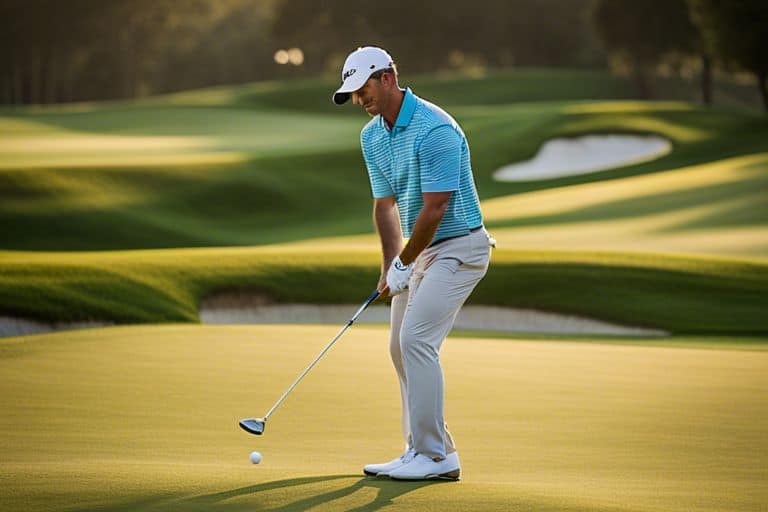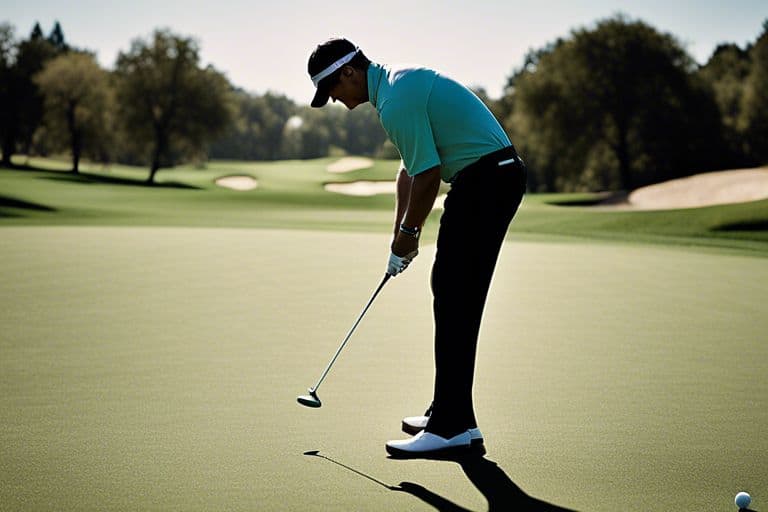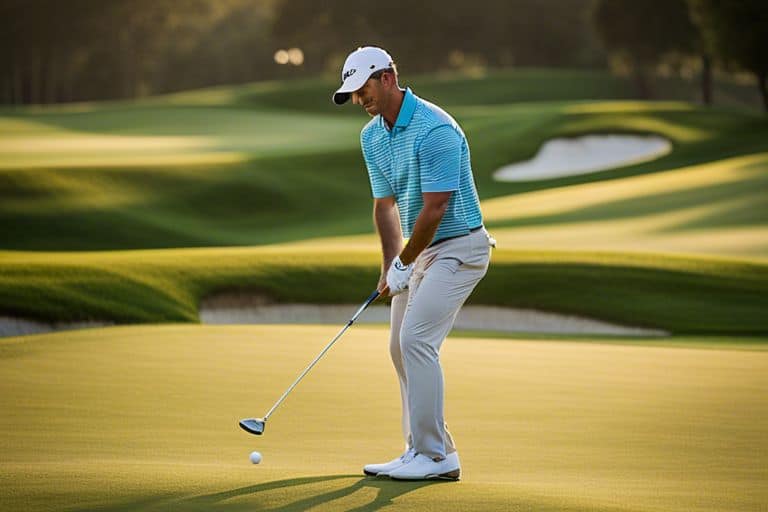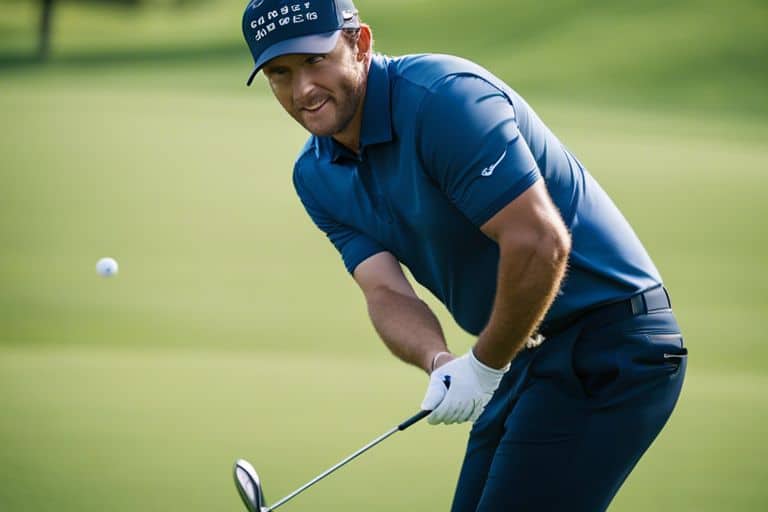How do you hit a "flop and roll" shot in golf?
Permit me to share with you some tried and tested techniques for executing the coveted “flop and roll” shot in golf. When faced with a short-sided pin and limited green to work with, mastering this shot can be the difference between dropping a stroke or two. The key to this shot lies in achieving maximum loft and soft landing, while still allowing the ball to roll out once it lands.
Fundamentals of the ‘Flop and Roll’ Technique
By mastering the ‘flop and roll’ technique, you can add a valuable shot to your golfing repertoire. This shot is especially useful when you need to hit the ball high and land it softly on the green. It requires a combination of technique, touch, and precision to execute successfully. In this chapter, I will go over the fundamentals of the ‘flop and roll’ technique to help you improve your short game.
Addressing the Golf Ball Correctly
When setting up for a ‘flop and roll’ shot, it is crucial to address the golf ball correctly. Position the ball slightly forward in your stance, just inside the left heel (for right-handed golfers). This allows you to hit down on the ball and generate the necessary height and backspin. Your stance should be open, with your feet flared out, to give you a better angle to attack the ball. Remember to maintain a wide and stable base, as this shot requires a delicate touch and precise contact with the ball.
The Art of the Backswing for ‘Flop and Roll’ Shots
The backswing for a ‘flop and roll’ shot is essential for success. As you take the club back, focus on a smooth and controlled motion. Don’t rush the backswing or try to generate too much power. Instead, focus on a gentle hinge of the wrists and a full turn of the body. This will help you maintain control and generate the necessary height for the shot. Keep your hands soft, and avoid using excessive wrist action or trying to lift the ball. Instead, let the loft of the club do the work for you, and trust in your technique to execute the shot successfully.
Executing the ‘Flop and Roll’ Shot
Some golfers find the ‘flop and roll’ shot to be one of the most challenging but also rewarding shots to execute on the course. It requires a delicate touch and precise execution to get the ball to pop up high and then softly roll towards the pin. Here, I will break down the key elements of how to successfully execute this shot, from the setup to the follow-through.
The Downswing and Impact Phase
As you approach the downswing and impact phase of the ‘flop and roll’ shot, it’s crucial to maintain a light grip on the club and focus on accelerating through the ball. The key is to maintain a steep angle of attack on the ball, allowing the club to slide under it and pop it up into the air. Keep your wrists loose and let the club do the work as you swing through the impact zone. It’s in this phase that you need to trust your technique and commit to the shot, maintaining a smooth tempo to avoid any mishits.
Controlling the Roll in ‘Flop and Roll’
Controlling the roll of the ball after the initial flop is crucial for setting up a good scoring opportunity. When executing the ‘flop and roll’ shot, focus on hitting the ball with a descending blow to generate backspin that will help control the ball’s roll after it lands. Additionally, the right club selection and proper assessment of the lie and green conditions are key factors in determining how much roll to expect after the ball lands. It’s important to practice this shot on different surfaces and lies to get a feel for how the ball will react and how much roll you can anticipate.

Advanced Tips for Perfecting Your ‘Flop and Roll’
However, once you have mastered the basics of the flop and roll shot, there are a few advanced tips that can help you perfect this challenging technique. Here are some key points to keep in mind:
- Adjusting Loft and Bounce for Different Lies
- Mastering Distance Control
Adjusting Loft and Bounce for Different Lies
When it comes to executing the flop and roll shot, adjusting the loft and bounce of your club is crucial for achieving the desired outcome. For tight lies, I recommend using a club with less bounce and opening the face slightly to increase loft. On the other hand, for fluffy lies, more bounce is needed to prevent the club from digging into the turf. Experiment with different clubs and angles to find the right combination for various lies on the course.
Mastering Distance Control
One of the most challenging aspects of the flop and roll shot is mastering distance control. It’s crucial to have a smooth, rhythmic swing and maintain a consistent tempo to achieve the right distance. Keep in mind that the power for this shot comes from the rotation of the body and the wrists, rather than a forceful swing. Practice different distances and focus on your follow-through to develop a feel for how far the ball will travel with each swing.

Practice Drills for the ‘Flop and Roll’ Shot
Your ability to consistently execute the ‘flop and roll’ shot in golf will greatly depend on your dedication to practicing the necessary skills. Here are some practice drills that can help you improve your performance and accuracy with this challenging shot.
Short Game Drills for ‘Flop and Roll’ Precision
When it comes to the ‘flop and roll’ shot, precision is key. One of the most effective drills for honing your precision is to set up a short game practice area with various targets at different distances. Start by hitting flop shots with the goal of landing the ball as close to the target as possible. Gradually increase the difficulty by adding obstacles or varying the lie of the ball. This will help you develop the touch and feel required for executing precise flop shots under different conditions.
Consistency Drills for the ‘Flop and Roll’ Technique
Consistency in your technique is essential for mastering the ‘flop and roll’ shot. One drill that can help you achieve this is to practice hitting flop shots from a variety of lies and slopes around the practice green. This will simulate real on-course conditions and challenge you to adapt your technique to different scenarios. Focus on maintaining a smooth, rhythmic swing and striking the ball cleanly each time. By practicing this drill regularly, you will develop the muscle memory needed to execute the ‘flop and roll’ shot with confidence and consistency on the course.
By incorporating these practice drills into your training routine, you can significantly improve your proficiency in the ‘flop and roll’ shot and elevate your overall performance on the golf course.

Conclusion
With these considerations in mind, mastering the “flop and roll” shot in golf can become an essential aspect of your short game arsenal. By utilizing the proper club, ball position, and swing technique, you can effectively execute this challenging shot with confidence and precision.
Practice and patience are key, and with dedication, you can become proficient in mastering the “flop and roll” shot, giving you the ability to navigate tricky course conditions and improve your overall game.






